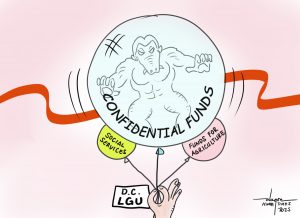“The shrewd person sees the danger and conceals himself, but the inexperienced keep right on going and suffer the consequences.” (Proverbs 27:12)
-oOo-
“Be prepared” is our Boy Scouts’ motto. Undoubtedly, this is a very useful admonition when we talk of disaster.
“Preparation is your most important key to survival!”, stressed an “Awake” brochure on disaster.
Some of the possible natural disasters that may confront us are storm, earthquake, fire, tsunami, flood, accident, terror attack and what have you. The brochure mentioned above listed down 6 things anent preparedness for disaster namely: 1. Prepare mentally, 2. Learn about disaster, 3. Prepare emergency supplies, 4. Have access to the needed phone number, 5. Make and rehearse an escape plan, and 6. Plan to help others.
One preparation vis-à-vis earthquake is to accurately identify the earthquake faults in our localities to guide any proposed development in the areas. Concerning earthquake faults in Davao City, the Philippine Institute of Volcanology identified these namely: Tamugan fault at Marilog District, Lacson and Dacudao faults in Calinan District, Colosas fault in Paquibato District, Biao Escuela and New Carmen faults in Tugbok District. The structural design of buildings and structures must be upgraded to resists intensity 8 earthquake at the very least.
It likewise listed down several pointers we must know during disaster such as: 1. Don’t panic but act quickly, 2. In a fire, get out of the burning building immediately. Help others if you still can. Stay close to the floor and move quickly to the nearest exit. Smoke is deadly. Leave personal things behind. Seconds can spell between life and death, 3. In an earthquake, go under a strong table or next to an inside wall. Expect aftershocks. Go outside of buildings with hands on your head asap. Help others if you can 4. In a tsunami. quickly go to a higher ground. Expect larger waves 5. In a storm. Go quickly to storm shelter, 6. In a flood. Leave flooded buildings but avoid wading in or driving through water, 7. If the authorities order evacuation follow immediately. Let your friends know where you are. Text messaging is more reliable, 8. However, if authorities order to stay at home, stay inside. Listen to local radio or TV news for further guidance.
The brochure also gives tips on what to do after a disaster happened. These are 1. Stay with friends, 2. Keep sanitation in your living space, 3. Use personal protective equipment, 4. Keep your routine as normal as possible, 5. Acknowledge that disaster cause loss 6. Recognize and address emotional injuries.
The brochure’s list of emergency supplies a family need to store are: 1. Blankets, warm clothes and sturdy shoes, 2. Flashlight, radio and spare batteries, 3. First-aid kit and a whistle, 4. Utensils, pocket tools and waterproof matches, 5. Dust masks, waterproof tape and plastic sheeting, 6. Toothbrushes, soap, towels and toilet papers, 7. Child-care, seniors and disabled supplies, 8. Waterproof container, medicines, prescriptions and important documents, 9. Contact numbers and maps, 10. Credit cards and cash, 11. Keys, paper, pencils, and games for children, 12. Bible.
Let’s talk of flooding in Davao City. Immediate solution is the dredging of our waterways especially the “mouths” of our rivers. Medium-term solution is effective drainage system. Long-term solution is massive and proper reforestation of our hinterlands.
Our dredging operations, to “shoot two birds with one stone” so to speak, should be accompanied with a huge reclamation project. On the other hands, our City Government must launch soon an honest-to-goodness massive reforestation project in the City’s hinterlands in partnership with our tribal leaders. Well-equipped Lumad forest rangers must be deployed by our city government in tandem with our police and military forces. Environmental and engineering solutions together will effectively address our flooding problem in the city.
Disaster Education must be taught in our schools. This must be accompanied by lectures on responsible stewardship of God’s creations. All our government and private institutions must adopt programs to this effect. With global warming at the horizon and knowing that the Philippines is one of the most vulnerable nations in this respect, the more urgent Disaster Education comes into the picture. “Di ba?”
The October Editorial of Mindanao Times rightly pointed out: “We however suggest that apart from the physical drills, the disaster management exercise should also include how to properly communicate or spread information so as not to aggregate an already tense situation.” “Tama!” Use ASAP radio and TV stations.
For instance, the long siren of the Davao CDRRMO last October 16 evening earthquake confused many Matina residents who panicky rushed to the Shrine hills for safety. They thought that said siren confirmed the (fake) news of a coming tsunami. “Dapat dalawang madaling maintindihang klaseng serene ang idisenyo ng ating “CDRRMOs. Such as 1) Continuous short waving blush for warning of a coming disaster and 2) Another long “sweet” blast for all-clear situation. All our coastal areas should now live under the shadow of sirens as global warming continues to rise. Effective system of sirens must be installed in all coastal barangay. Furthermore, my wife then called up 911 emergency line, nobody answered her call. Why?



